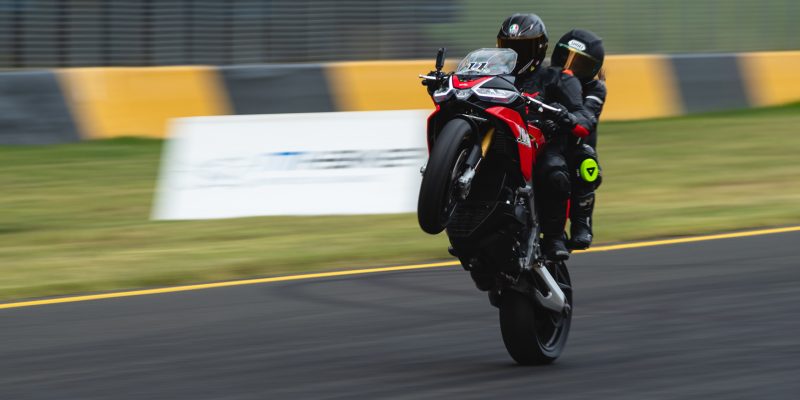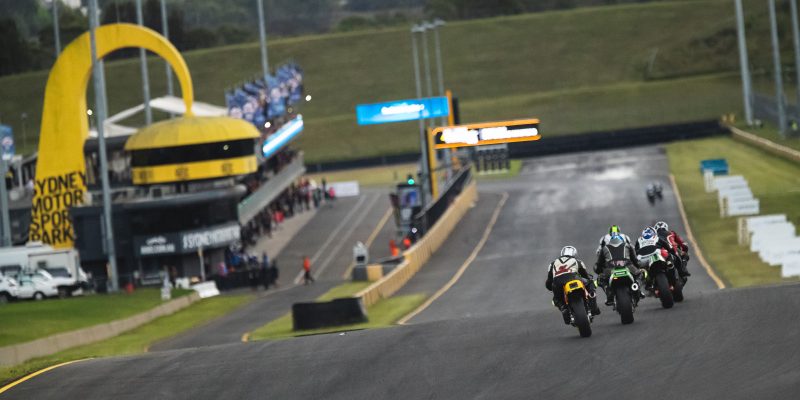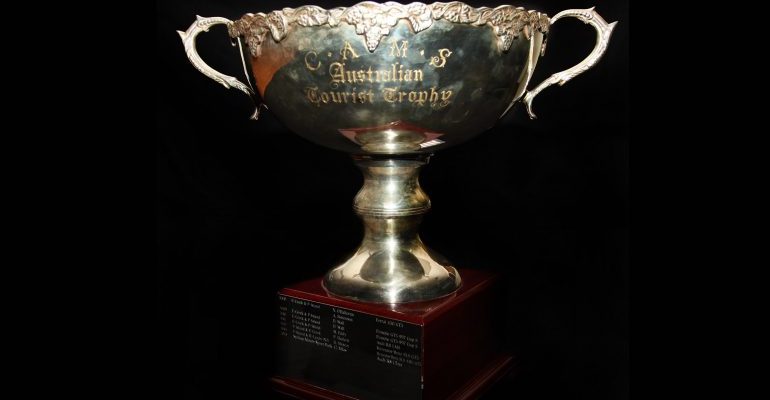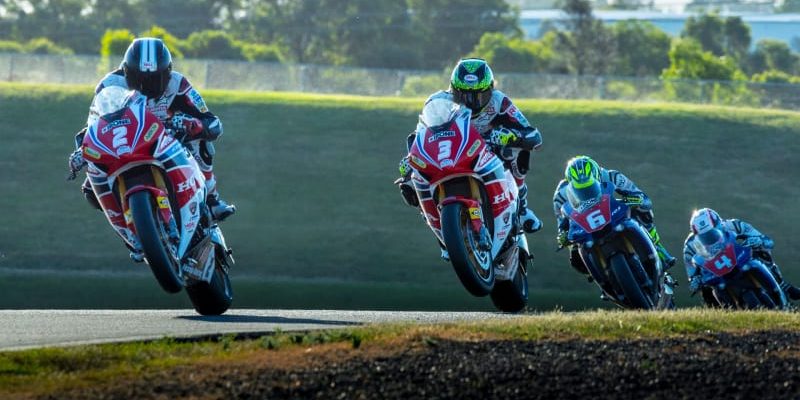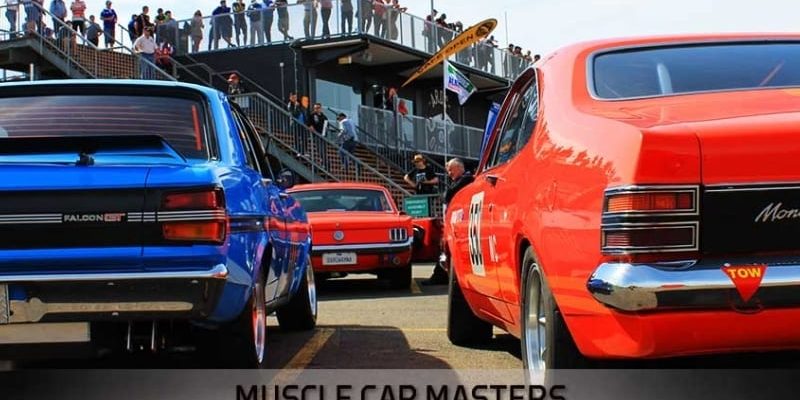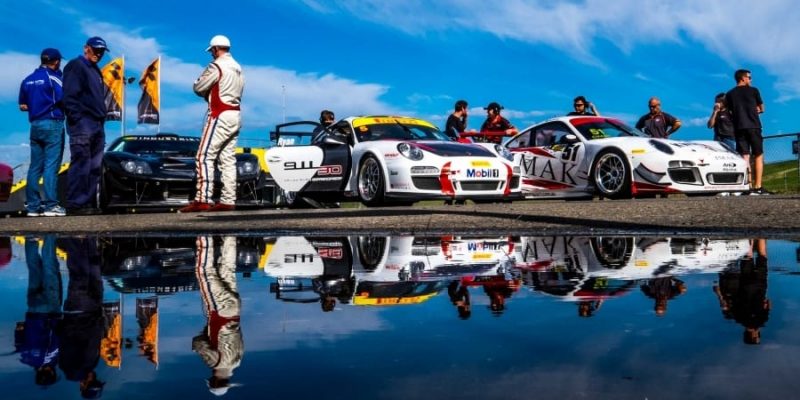News Archive
MEGA rides for another five years at Sydney Motorsport Park
November 27, 2023
- The Australian Racing Drivers’ Club (ARDC) and Motorcycling Events Group Australia (MEGA) jump onboard for another five years of SMSP Ride Days
- Continues an association that commenced in 1997
- Your Bike – Our Track program: from beginners to racers on the Brabham GP circuit at Australia’s premiere permanent race circuit
Sydney: The Australian Racing Drivers’ Club (ARDC) is pleased to announce the signing of a new five-year contract with Motorcycling Events Group Australia (MEGA), ensuring the continued success of ‘Your Bike – Our Track’ riding experiences at Sydney Motorsport Park, a partnership that commenced in 1997.
As operators of the NSW Government-owned Sydney Motorsport Park since 1996, the ARDC believes that to be the best you need to partner with the best; and certainly as far as motorcycle ride day operators go, none are better that Steve Brouggy and MEGA.
With over 600 different events per year, Sydney Motorsport Park is arguably one of the world’s busiest permanent race facilities. Outside of major events, motorsport experiences such as Ride Days, Track Days and Fastrack V8 Race experiences contribute to a significant percentage of calendar slots each year.
No strangers to hosting the country’s hottest two-wheeled action, throughout the course of a year, over 3,500 individual riders take to the track at SMSP ride days alone, covering over a staggering 750,000 kilometres during the multiple events.
Glenn Matthews, ARDC CEO, acknowledged the strategy of the Club was to partner with industry-recognised experience providers to present world-class products to the thousands of motorsport enthusiasts looking for the adrenaline rush that only motorsport can deliver, on a globally recognised circuit and in a safe and professional environment.
“Steve Brouggy and his MEGA team first joined the ARDC experiences family as far back as 1997, and have been the mainstay provider for that period. There is no better ride day operator in the country. His reputation and quality of product is without parallel, and the decision by the ARDC to ride pillion with MEGA for another five years to 2028 was a no-brainer”.
Steve Brouggy, MEGA Director, was equally excited about the new contract extension.
“I’m extremely happy to have signed with the ARDC to be the provider of SMSP Ride Days at Sydney Motorsport Park for another five years. Next year (2024) is the 30th year that Motorcycling Events Group Australia (MEGA) has been operating, and I can’t think of a better way to celebrate than with this new contract” said Steve.
“We became (and maintain) our position as industry leaders due to our constant engagement and attention on what happens during each and every event, and that will not change during the course of this contract period, or indeed any future extensions there might be. We are committed to developing and evolving every element of SMSP Ride Days to maximise every rider’s enjoyment and safety, and can’t wait to welcome new and returning riders in 2024 and beyond!”
Sydney Motorsport Park is located in Eastern Creek in Western Sydney, less than 40 minutes from the CBD, and is one of the country’s only racing facilities within a metro area.
About Motorcycling Events Group Australia (MEGA)
Motorcycling Events Group Australia (MEGA) is an industry leading provider of non-competitive racetrack activities (Ride Days) to the Australian motorcycle market, with 30 years’ experience in running these type of events. As the provider of SMSP Ride Days, MEGA uses the skills and experiences gained from its core staff having operated a variety of motorcycle training and track activities in 10 x countries at 45 x racetracks, bringing truly world standard flavour to a world standard venue. For further information: www.smsprd.com
THE ARDC GRAND PRIX
[fusion_builder_container hundred_percent=”no” equal_height_columns=”no” menu_anchor=”” hide_on_mobile=”small-visibility,medium-visibility,large-visibility” class=”” id=”” background_color=”” background_image=”” background_position=”center center” background_repeat=”no-repeat” fade=”no” background_parallax=”none” parallax_speed=”0.3″ video_mp4=”” video_webm=”” video_ogv=”” video_url=”” video_aspect_ratio=”16:9″ video_loop=”yes” video_mute=”yes” overlay_color=”” video_preview_image=”” border_size=”” border_color=”” border_style=”solid” padding_top=”” padding_bottom=”” padding_left=”” padding_right=””][fusion_builder_row][fusion_builder_column type=”1_1″ layout=”1_1″ background_position=”left top” background_color=”” border_size=”” border_color=”” border_style=”solid” border_position=”all” spacing=”yes” background_image=”” background_repeat=”no-repeat” padding_top=”” padding_right=”” padding_bottom=”” padding_left=”” margin_top=”0px” margin_bottom=”0px” class=”” id=”” animation_type=”” animation_speed=”0.3″ animation_direction=”left” hide_on_mobile=”small-visibility,medium-visibility,large-visibility” center_content=”no” last=”no” min_height=”” hover_type=”none” link=””][fusion_text columns=”” column_min_width=”” column_spacing=”” rule_style=”default” rule_size=”” rule_color=”” hide_on_mobile=”small-visibility,medium-visibility,large-visibility” class=”” id=””]
On the Saturday of the Bathurst 1000 this year (October 6) it will be exactly 60 years since the ARDC ran the 23rd Australian Grand Prix at Mount Panorama, Bathurst. At this fabulous meeting not only was the 1958 Australian Grand Prix decided but the 1958 Australian Tourist Trophy was run and won. This was the quaint old name given to the Australian Sports Car Championship. At the time Australian Motor Sports magazine described it as “the best motor racing meeting for some time”.
The Tourist Trophy was run over 26 laps of the 3.8 mile (6.115 kilometre) circuit at 3.10pm on Saturday October 5.
Many of the fancied entries were Jaguar powered such as Ron Phillips (Cooper Jaguar), Frank Cantwell from New Zealand (Tojero Jaguar), Bill Pitt (D Type), Jack Murray (D Type) and Frank Matich (C Type). There were 3 current model DB3S Aston Martins for David McKay, Tom Sulman and Warren Bloomfield. Another car which could not be discounted was Doug Whiteford’s 3 litre ex-works Maserati 300S.
Bill Pitt pushed the D Type Jaguar into the lead at the start from David McKay (Aston Martin DB3S), Derek Jolly’s little 1500cc Lotus 15 and Doug Whiteford (Maserati 300S). Whiteford easily worked his way up to the lead but on lap 10 he was caught by a gust of wind on the second hump on Conrod Straight. There was no Chase chicane in those days. Whiteford spun out of control straight through Murrays Corner and down the escape road to Bathurst. He bounced off four fences as he went almost being flung out of the car. Fortunately he suffered only bruising.
This left McKay comfortably in the lead from Jolly and Phillips. After a brief rain shower this was the final order after 26 laps.
Up until 1958 the Australian Grand Prix had always been a classic Formula Libre run what you brung type of race in which sports cars were often highly competitive. As an example of the increasing sophistication of Australian racing and the increasing number of competitive sports/racing cars in the country sports cars of any type were banned from the 1958 AGP. Even though the field was made up of open wheelers only there was tremendous variety in the best Formula Libre tradition.
There were big cars like the Alf Harvey 4.5 litre V12 OSCA which had run in the 1951 Italian GP. There were small cars like the Ralt Vincent of Noel Hall that finished third in heat 1 but failed to start in the GP itself. There were old cars like Ray Walmsley’s 1934 Grand Prix Alfa Romeo P3 whose original straight 8 supercharged engine was long gone. Like the Ern Seeliger Maybach, the Curly Brydon Ferrari and the Ted Gray Tornado Walmsley was relying on a new 260 cubic inch Corvette V8 to provide reliable lightweight power. Merv Neal’s Cooper (chassis F2/20/58) was probably the newest car – it even had disc brakes all round!
The field for the AGP was split into two heats which were held on Saturday afternoon. Heat one appeared to be for the slowest half of the field and heat two for the fastest.
Heat 1 was initially led by Allan Ferguson driving the spectacular Holden powered MG Special known as “Isk”. He was chased by the little air-cooled twin cylinder Ralt of Noel Hall and the Jaguar Special driven by Jack Robinson. Alf Harvey started slowly from pole position in the ex-Prince Bira OSCA 4500G. This car was famously fragile but as the heat progressed Harvey gained confidence and speed. He won the race with a fastest lap of 2.59.5 and a registered speed through the flying quarter mile of 133.33mph (214.573kph).
Heat 2 was for the fast cars. Gray was on pole in the Tornado Corvette but Jones’ Maserati led the field through Hell Corner from Mildren (Cooper) and Davison (Ferrari). On lap 2 Jones dropped oil on the exit of the cutting. Mildren spun on it and was hit by New Zealander Tom Clark (Ferrari Super Squalo). Gray hit the lead on lap 2 and won easily from Jones and Davison. Gray’s fastest lap was 2.50.0.
At the start of the Australian Grand Prix Jones jumped into the lead from Davison and pole man Gray. These three were 7 seconds clear of the rest after only 1 lap. New Zealander Clark passed Neil’s Cooper Climax on lap 2 and settled into a lonely 4th place.
By lap 10 Gray was 8 seconds clear of the battling Jones/Davison duo. 50 seconds behind was the Clark Ferrari with the Seeliger (Maybach) and Hawkes (Cooper Holden) fight another 4 seconds back. Clark dropped back and pitted on lap 18 with overheating. He continued but was much slower.
Alf Harvey in the OSCA was getting faster (2.58.0 fastest lap) but blew a spark plug clean through the bonnet and had to retire. Having led from lap 3 Gray pitted to report strange handling on lap 22. Fuel was sloshed around the fuel filler with only a small proportion going in. Gray was shouting at the mechanics but he was sent back out with no correcting action. He returned to the pits next lap after glancing off a barrier to have some chassis bolts tightened. After 2 slow laps the car was retired after achieving a fastest lap of 2.45.5 and a top speed of 155.17mph (249.722kph).
With the Tornado out Stan Jones was left in the lead. Lex Davison was all over him but Jones held him off even with a non-operating clutch in the Maserati. Coming down the mountain on lap 26 the Jones Maserati trailed thin, then thick blue smoke out of Forrest’s Elbow. Davison swept by and then slowed to coast to victory. He was just over 2 minutes ahead of runner up Ern Seeliger in the Maybach Corvette with Tom Hawkes 6 seconds back in the Cooper Holden.
In his victory speech at the presentation dinner Lex Davison referred to the Cooper Climaxes as “Anti-Climaxes”. History would show that a small rear engine car was the way of the future, even in Formula 1.
Incidentally it has been 20 years since the ARDC last ran a race meeting at Mount Panorama, Bathurst. That was the 1998 AMP Bathurst 1000. Also it was just over 20 years ago, in August 1998, that Amaroo Park hosted its last meeting. The registered office of the ARDC was at Amaroo Park in Annangrove from 1970 to 1996.
Brian Goulding
[/fusion_text][/fusion_builder_column][/fusion_builder_row][/fusion_builder_container]
Australasian Superbike/FX Superbike Rd 7 Finale 2015
Finishing the year at Sydney Motorsport Park is a huge highlight for the whole Australian SuperBike racing fraternity. With most of the category championships still up for grabs, and some very finely balanced with as little as one point separating riders, this final round is closely watched by team statisticians.
It is an especially nervous time for family, too. In fact, I stood beside Brayden Elliots’ aunt while Brayden rode for his tilt at the Swann ASBK Supersport championship on Saturday in which he was tied after six laps with arch rival Callum Spriggs, and my ears are still ringing from the enthusiastic yelling and screaming.
In a move away from the usual Saturday/Sunday race meetings, ASBK organisers elected to make it a Friday/Saturday schedule with racing starting later on each day in order to run the timetabling through into a “twilight” meet in an attempt to offer “after work” racing for spectators on Friday night. It’s a creative attempt by organisers to bring more spectators to the event and cater for our ever changing social habits.
Friday saw the completion of the FX Extreme 2015 racing calendar. Whilst most were racing to end the season strongly Sugar Plum Racings’ Richard Draper was just pleased to be back in leathers following an absence since May due to shoulder surgery. Also in Pro Twin Craig Masters had spent the morning sorting out serious brake issues only to have to push the bike all the way back from turn 18 due to an oversight when someone forgot to fill the fuel tank. As he said”…with a thousand other things going on someone forgot to fill me up”.
Race one of Pro Twin/Naked Bikes early on Friday was a terrible way for championship frontrunner Kris Keen to start his campaign to win his championship. Both his bike and Chris Perini’s both failed to start off the grid and had to be pushed aside. Ben O’Connor jumped the start earning him a 5 second penalty. Craig McMartin was having a stellar race until Beau Beaton, who’d been shadowing him closely, jumped him on the second last lap taking the lead. Not happy McMartin waited his chance and slipstreamed Beaton all the way from turn 18 crossing the line two thousandths/second ahead of Beaton. Visually there was no appreciable difference between the bikes at the finish line. They actually looked like they crossed the line in a dead heat. Race Two saw neither Beau Beaton or Craig McMartin start. This left the field wide open for series leaders Kris Keen and Adrian Pierpont to further stamp their ownership on the title race. Unfortunately Darren Jones had other ideas with an 8 second runaway win from Pierpont as he and Keen crossed like Siamese twins side by side with only five thousands/second separating them. It’s incredible that the timing equipment can record such miniscule time differences.
Formula Oz, sometimes known as the “race what you brung” event, saw double duty for McMartin, Perini and Beaton. Beaton was pushed off the start grid with engine trouble and Perini failed to finish. McMartin however was mixing it up the front with category champion Paul Byrne, leading for most of the race until a last lap charge from Byrne took the lollies away from McMartin . Third place Ben Henry stayed comparatively close to the leaders and had left the main pack well behind. Race two was also a close affair as Beau Beaton got his troubled bike going again and put on a spectacular race with Paul Byrne that had the crowd running back and forth across the pit rooftop not wanting to miss any of the action. Once again Ben Henry had a nine second lead on the main pack but was unable to find the extra second he needed to get past Byrne to challenge Beaton. Side by side across the line and Beaton just edged out Byrne for the win.
Fridays Superbikes set up a tension filled expectation that something awesome was about to unfold. The last race on the FX Xtreme calendar did not disappoint. As the lead group of Troy Herfoss, Wayne Maxwell , Glenn Allerton and Cru Halliday ripped up the track it was very obvious that the championship was going to be earned the hard way today. And so it came to pass that Herfoss finally got his championship when pushing so hard Maxwell took a tumble at turn nine leaving Herfoss the 2015 FX Xtreme champ. Unhurt but disappointed Maxwell could only look forward to Saturdays three-race ASBK program to avenge his loss.
Saturday the Swann Australian Superbike program was unleashed and the day started with the eFXC electric bikes. Making a medium-high pitched whirring sound rather than a throaty roar it was quite strange to see these bikes hurtling down the main straight at 239 kph semi-quietly. The Voltron Evo piloted by Danny Pottage is clearly the faster bike and competently ridden giving him the 5 race wins during the weekend.
The Ninja FX-300 battle deluxe was really about who was going to take the second and third place trophies. Paul Young has a significant point lead and his two race wins today solidified his championship position. Only 21 points separated the next four riders which included Tony Jones and Jack Dawes who split the best results for the minor placings with Jones recording a 1-4-4 race record and Dawes a 3-2-2 all podium day.
Supersports was earmarked on the program as a definite “do not miss”! In particular all year there has been a fierce competitive chemistry between Callum Spriggs and Brayden Elliot. Coming into todays racing only nine points separated the pair. Add to the mix Michael Blair who wasn’t out of contention either only 24 points back of Elliot. So when Blair took race one with Elliot in second, Spriggs lead was dwindling. They were coming after him. Race two and Elliot reversed the win-second relationship with Blair and Spriggs was relegated to fourth. The tension on the pit lane balcony was palpable. As I mentioned previously Elliots’ aunt was a nervous wreck. So race three, the absolute final race of the year and Spriggs and Elliot are separated by only one point. A real cliffhanger. Eight laps from glory. They line up, the starter sends them on their way and Elliot gets the better start. Spriggs hasn’t started particularly well all day and ends up hitting the first turn in sixth. Troy Guenther decides to throw it all down and squeezes Elliot wide in turn two to take the lead. Elliot seems to settle in to a “stay close to Guenther” mindset all the while keeping a watch in his rears hoping like crazy that Spriggs gets caught in traffic. Calculating on the fly it appears that all Elliot needs is for there to be one rider between him and Spriggs come the chequered flag.
By lap five Spriggs has jumped up two places sitting in fourth. Elliot turns on the power and is now trying everything he can to edge past Guenther. He does on two occasions through turn two only to be thwarted by Guenther holding him at bay both times. Its mid lap seven and Spriggs eventually gets past Blair into third spot and is hammering towards turn nine looking to try and put a final move on Elliot. Spriggs brakes super late into nine and finds himself so wide on the exit that he’s in the dirt. Lost opportunity and Elliot squirts away. Elliot now knows that he must get past Guenther if he is a chance to win the championship. Elliot jumps on the juice even before he’s out of turn eighteen trying to slipstream Guenther down the straight. He’s so so close… even riding the fastest lap of the race at 1:30.06 with a top speed of 256kph. He’s within two one thousands /second of Guenther across the line. First-Guenther…Second -Elliot…Third – Spriggs. BUT…its not over yet. The drama continues. Now both Elliot and Spriggs finish equal on 373 points. TIE!!! The rules say that a countback on quantity of podium finishes are the mechanism by which a stalemate is to be broken. With eleven podiums Spriggs is awarded the victory in this most enthralling series.
The Superbikes came to battle with an already tied series. Wayne Maxwell (Yamaha) and Troy Herfoss (Honda) are locked at 316 points. Allerton (Yamaha) is not out of it either only 34 points adrift. Three races away from deciding the “king of the mountain” Australian SuperBike Championship. And race one was exhausting to watch. It was by far one of the best races of the series. Herfoss held pole. Crappy start and all of a sudden in the blink of an eye he’s in fifth place by turn two. Jamie Stauffer (Honda) grabs lead but with superior straight line speed Mike Jones (Kawasaki) takes it away from Stauffer. Stauffer puts on an underarm move on Jones at turn two but runs his line wide and Jones takes it back with a “thank you very much” move. Stauffer using his craftiness takes and holds the lead while Herfoss took no prisoners moving back up to third and attacking Jones. Running wide on the last lap Herfoss’ chances went out the window and Stauffer held on for a magnificent win. Maxwell finished fourth. Advantage Herfoss! Race two and Mike Jones just went nuts. Herfoss hung on and Maxwell too. They both knew that there could be no other rider between them if they were going to keep the points differential to a minimum. Maybe there is something in the saying…” keep your friends close but your enemies closer”. Race two finished Jones to Herfoss to Maxwell. Just out of the podiums Glenn Allerton was only five onethousands/second away. Race three and for the first time all day Herfoss saw what the back of Maxwells bike looked like. Jones once again took off like a scalded cat and Stauffer, who didn’t feature in race two, suddenly unleashed the beast he had brought to race one. He and Jones ended up only one- onethousandths/second apart at the line and Maxwell so close they could have all been triplets. Herfoss was within two seconds of the lead group but one suspects that he already knew what the outcome of this race meant for him. If the fact that he came in the back gate standing on his pegs with arms outstretched to the heavens and one finger on each hand pointing skyward said anything then we all knew that we were looking at the new 2015 ASBK Superbike Champion.
Words and pics by Rob Annesley
www.shotbyrob.com.au
New era begins for Muscle Car Masters
The Australian Muscle Car Masters has a new slot on the motor racing calendar for 2016: the last weekend in October.
The nation’s most successful retro motorsport event had been run at Sydney Motorsport Park (Eastern Creek) on the Father’s Day weekend in September for the past 10 years. In an announcement today from the joint-venture partners, the Australian Racing Drivers’ Club Ltd and nextmedia Pty Ltd (publishers of Australian Muscle Car magazine), the 2016 event will be run on the weekend of October 29-30.
By popular demand, this date change will successfully separate the Australian Muscle Car Masters from the venue’s round of the 2016 V8 Supercars championship. Both meetings have been run in close proximity for the last three years, including twice on consecutive weekends.
The move to late October will be welcomed by competitors, officials and motorsport enthusiasts and is expected to boost crowd attendance at both events.
The date change will be especially popular with those previously unable to attend ‘the Masters’ due to Father’s Day family commitments.
The full line-up of race categories and new on-and-off-track activities will be announced early in 2016.
The ultra-popular Pit Straight Car Club Corral and Featured Muscle Marques display and parade will have twin focuses in 2016. Ford’s contribution to Australia’s performance heritage will be celebrated in the month the company winds up manufacturing in this country. Meanwhile, Brock Commodore owners will be encouraged to attend to mark the 10th anniversary of Peter Brock’s passing and 30 years since the launch of the VL Group A.
MRC Final Round Wrap!
The 2015 NSW Motor Race Championships came to a close amongst hot temperatures on and off the track. Close to 160 competitors, some with very real hopes of clinching their category titles waxed, polished and tinkered with their cars right up until their call to the dummy grid came over the loudspeakers.
This event featured the SuperSports category replacing Formula Vee who finished their season at the last round in September with their 2015 championship going to Michael Kinsella ( 1st). Only 5 points behind him was Ryan Reynolds (2nd) and Dylan Thomas (3rd). In a regularly huge field of 30-plus cars rookie Aaron Pace finished the year in 10th place.
The Production Sports category had their hour-long enduro which mandated a Driver A & B mid-race change. For those entrants not electing to use a “driver B” then a 45 second mandatory “sit in car” rule applied. During race one Andrew MacPherson (Porsche GT3) spun at turn 15 and softly collided with the wall and didn’t finish the Driver A race. Undaunted, he went on to win the Driver B race and ultimately the 60 minute enduro single-handledly. The Straight Eight Racing pairing of Iain Pretty/Scott Fleming placed second and fourth in the Driver A&B races, and after an hour long race ended up taking second place only 45 sec behind MacPherson at the chequered flag. Neale Muston (solo drive) rounded out the podium.
Championship victories are full of stories of how adversity has been overcome. Dylan Thomas’s victory in Production Touring is one such tale. Leading his category going into the weekend all he needed was a clean weekend and the championship was his. Taking pole in qualifying everything seemed to be going to plan until he came to stop in an almighty billow of black smoke at turn 3 during race one. Oh-oh!! Plan derailed? Not a quitter, Team CXC got Dylan back out there and in the following two races a first and second placings assured that his fairytale was going to become a reality. One small note Id like to mention in this category. As spectators we often don’t see the sportsmanship that goes on between drivers on the track. One such occurance saw Michael Caine relinquish a podium place to allow Dylan Thomas some passing room and ultimately a small amount of breathing space towards his quest for the championship. Nice one Michael.

The mighty HQ duel that we saw at last month’s round six championship event between John Baxter and Brett Osborn continued as if a month hadn’t passed. They picked up exactly where they left off. Side by side…nose to tail. Again, only nano seconds split them during qualifying. That is until Osborn’s nemesis took hold. Two poor starts in races one and two made his workload untenable. A fifth place in race one saw him with a mountain of work to do on Sunday. Pushing so hard to catch up places in race two had him locking up brakes and some uncharacteristic off line driving including dirt bashing at turn 2. To his credit he clawed back twelve places through the field to finish in sixth to go with his fifth in race one, but a win and a second to Baxter in the first two races handed him the 2015 championship. Baxter didn’t get it done easily though as the triumvirate of Molle, Buckley and Cambridge crowded him in and at times seemed to form an impenetrable barrier. Baxter only had to finish race three to take the crown and we don’t know how much Baxter knew of his fuel situation but he conked out just after crossing the finish line in race three and had to be pushed home nose to tail by good samaritan Tony Camillieri. It could have been an altogether different result. High tension in the house of HQ.
Sports Sedans have delighted us all year with their huge sculptured bodies and loud exhausts. I reported on Birol Seton’s unfortunate mishap last month, and he unfortunately didn’t get his repairs done in time to join the racing again this year. We look forward to seeing him next year as he is one of our most spirited racers. In all my reports throughout the year Steve Lacey (Camaro) has featured as coming second or third in the majority of his races. He is as persistant and determined a racer as you could ever hope to meet and should be held as an example to all young aspiring hopefuls that crossing the finish line first isn’t necessarily the only way to win. Being there every race meeting, competing hard and fair, and just having a strong dogged determination and love of the sport is an admirable attitude to bring with you every race day. The saying “nice guys finish last” is definitely not true about Steve! To illustrate Steve’s talent and hardened resolve in the face of adversity he suffered bouts of brake problems throughout the year and this weekend drove race two without fourth and fifth gear and all of race three without a clutch grabbing what ever gear he could to get the job done. Steve took the championship this year from hearty competitors Simon Copping and Grant Doulman.

Formula Cars Darren Choon came out in qualifying with a massive purpose. To unseat his arch rival Nic Filipetto. Ready on the grid side by side for race one the tension could be felt by the rooftop spectators. For some reason the stance of open wheelers look like they’ve come ready for battle. Choon and Filipetto……Filipetto and Choon. The race callers had to keep reaching for their binoculars to be sure who had the lead. Choon took first blood in race one but I suspect that Filipetto’s brake lockup puffs of smoke had a bit to do with that result. Sure enough, speaking with Filipetto later confirmed that a 6% overrotating on the brake cylinder valve had too much brake being applied and also some overinflation of the tyres. Set to go for race two and Nic threw down a smoother lap flow and slightly quicker times giving him the race and championship win.
Thanks to all our hard working race officials, track marshalls and all the unsung heroes who without their hard work and dedication by turning up every race day we couldn’t bring you these fantastic and enjoyable race meetings.
Words and pictures by Rob Annesley
www.shotbyrob.com.au
look@shotbyrob.com.au

